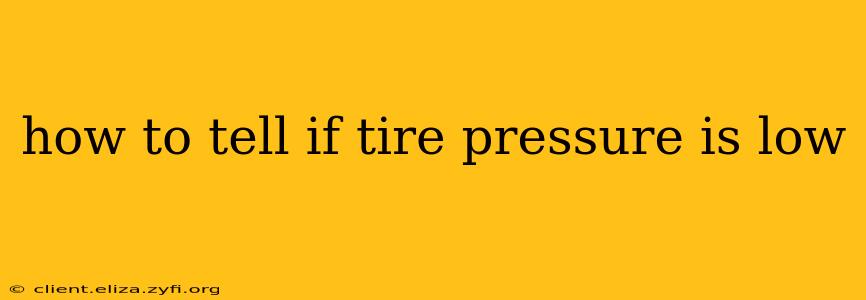Maintaining proper tire pressure is crucial for safety, fuel efficiency, and tire longevity. Driving on underinflated tires can lead to accidents, reduced gas mileage, and premature tire wear. Knowing how to check and identify low tire pressure is a vital skill for every driver. This guide will walk you through various methods to determine if your tires need air.
What are the Signs of Low Tire Pressure?
Several indicators can alert you to low tire pressure, even before you use a gauge. These are often subtle at first, but it's important to learn to recognize them.
-
Visual Inspection: A noticeably flattened or deflated tire is the most obvious sign. Look for tires that appear smaller or less round than usual. This is a clear indication of significantly low pressure.
-
Handling Changes: Low tire pressure often affects your vehicle's handling. You may notice:
- Increased braking distance: It takes longer to stop.
- Poor handling: The car may feel wobbly, unstable, or difficult to control, especially at higher speeds.
- Pulling to one side: The car might veer to the left or right.
-
Ride Comfort: Underinflated tires can lead to a bumpy, less comfortable ride. You might feel more vibrations or road imperfections.
-
TPMS Warning Light: Modern vehicles are equipped with Tire Pressure Monitoring Systems (TPMS). This system uses sensors to monitor tire pressure and illuminates a warning light on your dashboard when pressure drops below a certain level. This is a critical indicator and should be addressed immediately.
-
Checking Your Tire Pressure Gauge: The most reliable way to determine if your tire pressure is low is by using a reliable tire pressure gauge. This method allows for precise measurement and eliminates guesswork.
How Often Should I Check My Tire Pressure?
Ideally, you should check your tire pressure at least once a month, and before any long journeys. Remember to check when the tires are cold (i.e., haven't been driven for at least three hours). This is because tire pressure increases with heat from driving.
What is the Recommended Tire Pressure?
The recommended tire pressure for your vehicle is not a universal number. It's specified in your owner's manual, typically on a sticker located on the driver's side doorjamb, or inside the fuel filler door. Always refer to your owner's manual for the correct tire pressure. This pressure is often expressed in PSI (pounds per square inch) and may vary depending on the tire size and load capacity.
What Happens if I Drive with Low Tire Pressure?
Driving with significantly low tire pressure can have several negative consequences:
- Increased risk of a blowout: Underinflated tires are more susceptible to damage and blowouts, which can lead to accidents.
- Reduced fuel efficiency: Underinflation increases rolling resistance, leading to lower gas mileage.
- Premature tire wear: Uneven wear on the tire treads is common, shortening their lifespan.
- Damage to the tires and wheels: Constant driving on low pressure can damage both your tires and the wheels themselves.
How to Properly Inflate Your Tires?
Once you've determined your tires need air, use a reliable air compressor or a gas station air pump to inflate them to the pressure recommended in your owner's manual. Make sure to check the pressure regularly and maintain the proper inflation.
How do I find the correct tire pressure for my car?
This information is clearly printed within your vehicle's owner’s manual, often also found on a sticker inside the driver's side doorjamb or fuel filler door. This sticker will provide the recommended tire pressure in PSI (pounds per square inch) for both your front and rear tires.
What does the TPMS light mean?
The TPMS (Tire Pressure Monitoring System) warning light illuminates on your dashboard when one or more of your tires is significantly underinflated. Do not ignore this light. It is a critical safety indicator requiring immediate attention. Check your tire pressures and inflate them as necessary.
Can I use a digital or analog tire pressure gauge?
Both digital and analog tire pressure gauges are reliable tools for measuring tire pressure. Digital gauges generally offer higher precision, while analog gauges are simpler and often more durable. Select a gauge you find easy to use and reliable for consistent measurements.
This guide offers comprehensive advice on recognizing and resolving low tire pressure issues. Remember, safety and fuel efficiency are vital; regular tire pressure checks are a simple way to ensure your vehicle is in optimal condition.
